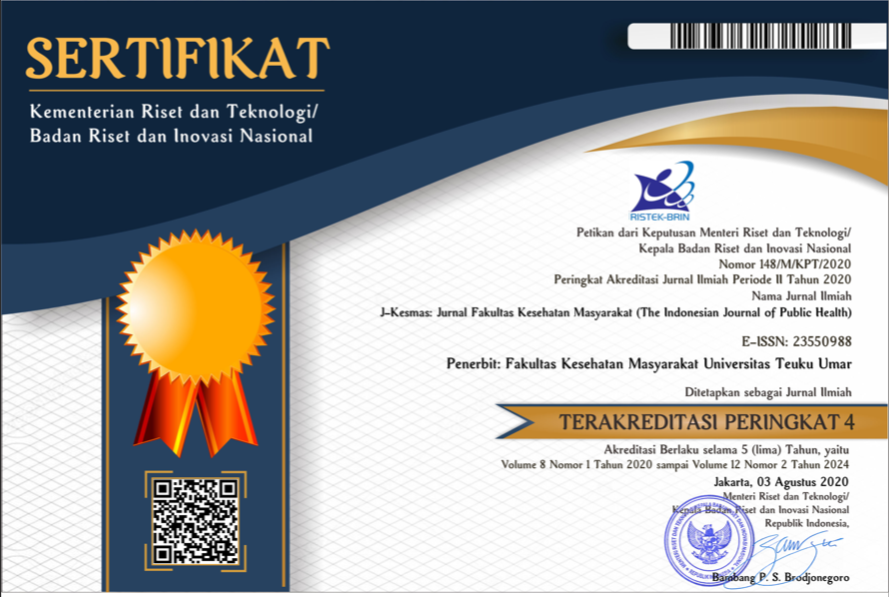Evaluation of Cervical Cancer Screening System using Visual Inspection with Acetic Acid (VIA) Method in Bantul District 2023
Abstract
Background: Cervical cancer remains a significant public health challenge globally, particularly in Indonesia, where it disproportionately affects women of various age groups. This study aims to evaluate the cervical cancer screening surveillance system in Bantul District in 2023, a region chosen for its low cervical cancer screening coverage and its significance as a representative area for rural public health challenges in Indonesia. Method: This descriptive study uses secondary data from the Visual Inspection with Acetic Acid (VIA) screening report conducted at Public Health Centers (PHCs) in Bantul District. The evaluation focuses on core functions (case detection, registration, reporting) and surveillance quality (completeness of data and reporting from PHCs). Results: Data were analyzed descriptively using percentages and frequencies. There were 27 PHCs, and 92,59% reported screening results. Jetis II PHC reported the highest screening coverage (9.60%) and Kasihan II PHC recorded the highest positive cases (21,15%). 24 PHCs (96%) used the patient registration form provided by the Health Office. Of 2.321 screened women, 52 were reported positive with 51.9% of cases having no follow-up records. The completeness of reporting from PHCs reached 95.68%, while the completeness of data averaged 61.76%, with a range of 4.35%-100%. Conclutions: The study relied on secondary data, which limited the ability to explore in-depth contextual factors and stakeholder perspectives, emphasizing the need for qualitative follow-up to enhance understanding. Capacity building of health workers in screening and reporting is required along with the development and implementation of Standard Operating Procedures (SOPs), which is critical to improving the program.
Keywords
Full Text:
PDFReferences
Arbyn, M., Weiderpass, E., Bruni, L., Sanjosé, S. de, Saraiya, M., Ferlay, J., & Bray, F. (2020). Estimates of incidence and mortality of cervical cancer in 2018: A worldwide analysis. The Lancet Global Health, 8(2), e191–e203. https://doi.org/10.1016/S2214-109X(19)30482-6
Arora, R., & Gupta, S. (2021). Barriers to cervical cancer screening in rural India: A qualitative study. Asian Pacific Journal of Cancer Prevention, 22(5), 1451-1457. doi:10.31557/APJCP.2021.22.5.1451
Ayu, S., & Hadi, E. N. (2024). Visual inspection with acetic acid screening use determinants: A systematic literature review. BKM Public Health and Community Medicine, e12397–e12397. https://doi.org/10.22146/bkm.v40i04.12397
Farajimakin, O. (2024). Barriers to Cervical Cancer Screening: A Systematic Review. Cureus, 16(7), e65555. https://doi.org/10.7759/cureus.65555
Information Centre on HPV and Cancer. (2023). Indonesia: Human Papillomavirus and Related Cancers, Fact Sheet 2023. Fact Sheet. https://hpvcentre.net/statistics/reports/IDN_FS.pdf
Lohiya, A., Daniel, R. A., Kumar, D., Varghese, C., Rath, R. S., Abdulkader, R. S., & Nongkynrih, B. (2022). Effectiveness of Visual Inspection with Acetic Acid (VIA) Screening on Cervical Cancer Mortality and Incidence—A Systematic Review and Meta-Analysis. Asian Pacific Journal of Cancer Prevention : APJCP, 23(2), 399–407. https://doi.org/10.31557/APJCP.2022.23.2.399
Parija, J., Mohapatra, J., & Padhy, A. (2017). Manuscript of risk factors for cancer cervix: An analysis of 1000 cases. International Journal of Research in Medical Sciences, 5(8), 3364–3367. https://doi.org/10.18203/2320-6012.ijrms20173079
Robbers, G. M. L., Bennett, L. R., Spagnoletti, B. R. M., & Wilopo, S. A. (2021). Facilitators and barriers for the delivery and uptake of cervical cancer screening in Indonesia: A scoping review. Global Health Action, 14(1), 1979280. https://doi.org/10.1080/16549716.2021.1979280
Smith, J. A., & Brown, L. M. (2022). The impact of follow-up care on cervical cancer outcomes: A systematic review. Journal of Cancer Research and Clinical Oncology, 148(3), 567-578. doi:10.1007/s00432-021-03567-8
Singh, D., Vignat, J., Lorenzoni, V., Eslahi, M., Ginsburg, O., Lauby-Secretan, B., Arbyn, M., Basu, P., Bray, F., & Vaccarella, S. (2023). Global estimates of incidence and mortality of cervical cancer in 2020: A baseline analysis of the WHO Global Cervical Cancer Elimination Initiative. The Lancet Global Health, 11(2), e197–e206. https://doi.org/10.1016/S2214-109X(22)00501-0
Tabassum, R., Tisha, T., Boey, E., Rahman, N., Halkiyo, A. B., Hussein, A. J., Dedefo, A., Bekele, E., Pierz, A. J., Tefera, B., MadhVIAnan, P., & Lott, B. E. (2024). Imparting Knowledge to Others: A Qualitative Study Exploring How Ethiopian Women Prefer to Receive Cervical Cancer Education. JCO Global Oncology, 10(Supplement_1), 4–5. https://doi.org/10.1200/GO-24-10000
Tsu, V., & Jeronimo, J. (2022). Scaling up cervical cancer screening in low-resource settings: Lessons learned from the HPV vaccination experience. Lancet Global Health, 10(4), e500-e501. doi:10.1016/S2214-109X(22)00045-2
World Health Organization. (2021). Global strategy to accelerate the elimination of cervical cancer as a public health problem. Geneva: World Health Organization. https://www.who.int/publications/i/item/9789240000000
DOI: https://doi.org/10.35308/j-kesmas.v12i1.12087
Refbacks
- There are currently no refbacks.
Managed by Fakultas Kesehatan Masyarakat
Published by Universitas Teuku Umar
Website: http://jurnal.utu.ac.id/jkesmas
Email: jkemas@utu.ac.id 
This work is licensed under a Creative Commons Attribution-ShareAlike 4.0 International License.







.jpg)


